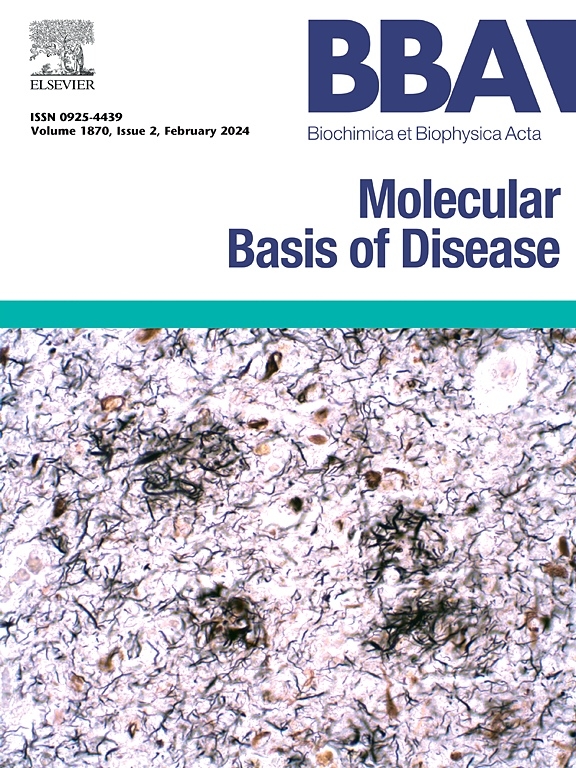Hyperglycaemia induces diet-dependent defects of the left-right axis by lowering intracellular pH
IF 4.2
2区 生物学
Q2 BIOCHEMISTRY & MOLECULAR BIOLOGY
Biochimica et biophysica acta. Molecular basis of disease
Pub Date : 2024-10-21
DOI:10.1016/j.bbadis.2024.167550
引用次数: 0
Abstract
Pregestational diabetes is a risk factor for congenital anomalies, including heterotaxy syndrome, a rare birth defect characterized by the abnormal arrangement of organs relative to the left-right (L-R) body axis. To provide insight into the underlying mechanism by which diabetes induces heterotaxy, we here analyzed the L-R axis of mouse embryos of diabetic dams. Various Pitx2 expression patterns indicative of disruption of L-R axis formation were apparent in such embryos. Expression of Nodal at the node, which triggers a Nodal-Pitx2 expression cascade in lateral plate mesoderm, showed marked regression associated with L-R axis malformation. This regression was similar to that apparent in Wnt3a−/− embryos, and canonical Wnt signalling was indeed found to be downregulated in embryos of diabetic dams. RNA sequencing revealed dysregulation of glycolysis in embryos of diabetic dams, and high glucose lowered intracellular pH in the primitive streak, leading to the suppression of Wnt signalling and the regression of Nodal expression. Of note, maternal vitamin A intake increased the incidence of L-R axis defects in embryos of diabetic dams, with dysregulation of retinoic acid metabolism being apparent in these embryos and in Wnt3a−/− embryos. Our results shed light on the mechanisms underlying embryopathies associated with maternal diabetes and suggest the importance of diet for prevention of heterotaxy.
高血糖通过降低细胞内 pH 值诱发饮食依赖性左右轴缺陷。
妊娠糖尿病是先天性畸形的一个风险因素,包括异轴综合征,这是一种罕见的先天缺陷,其特征是器官相对于身体左-右(L-R)轴的异常排列。为了深入了解糖尿病诱导异轴的内在机制,我们在此分析了糖尿病母鼠胚胎的 L-R 轴。在这些胚胎中,各种表明 L-R 轴形成中断的 Pitx2 表达模式显而易见。节点处的 Nodal 表达会触发侧板中胚层中的 Nodal-Pitx2 表达级联,这种表达的明显衰退与 L-R 轴畸形有关。这种退行与 Wnt3a-/- 胚胎中的退行相似,而且在糖尿病母体的胚胎中确实发现典型的 Wnt 信号下调。RNA 测序显示,糖尿病母鼠胚胎中糖酵解失调,高糖降低了原始条纹细胞内的 pH 值,导致 Wnt 信号受抑制和 Nodal 表达减弱。值得注意的是,母体维生素 A 的摄入增加了糖尿病母体胚胎 L-R 轴缺陷的发生率,这些胚胎和 Wnt3a-/- 胚胎的视黄酸代谢明显失调。我们的研究结果揭示了与母体糖尿病相关的胚胎病理机制,并提示了饮食对预防异位症的重要性。
本文章由计算机程序翻译,如有差异,请以英文原文为准。
求助全文
约1分钟内获得全文
求助全文
来源期刊
CiteScore
12.30
自引率
0.00%
发文量
218
审稿时长
32 days
期刊介绍:
BBA Molecular Basis of Disease addresses the biochemistry and molecular genetics of disease processes and models of human disease. This journal covers aspects of aging, cancer, metabolic-, neurological-, and immunological-based disease. Manuscripts focused on using animal models to elucidate biochemical and mechanistic insight in each of these conditions, are particularly encouraged. Manuscripts should emphasize the underlying mechanisms of disease pathways and provide novel contributions to the understanding and/or treatment of these disorders. Highly descriptive and method development submissions may be declined without full review. The submission of uninvited reviews to BBA - Molecular Basis of Disease is strongly discouraged, and any such uninvited review should be accompanied by a coverletter outlining the compelling reasons why the review should be considered.

 求助内容:
求助内容: 应助结果提醒方式:
应助结果提醒方式:


